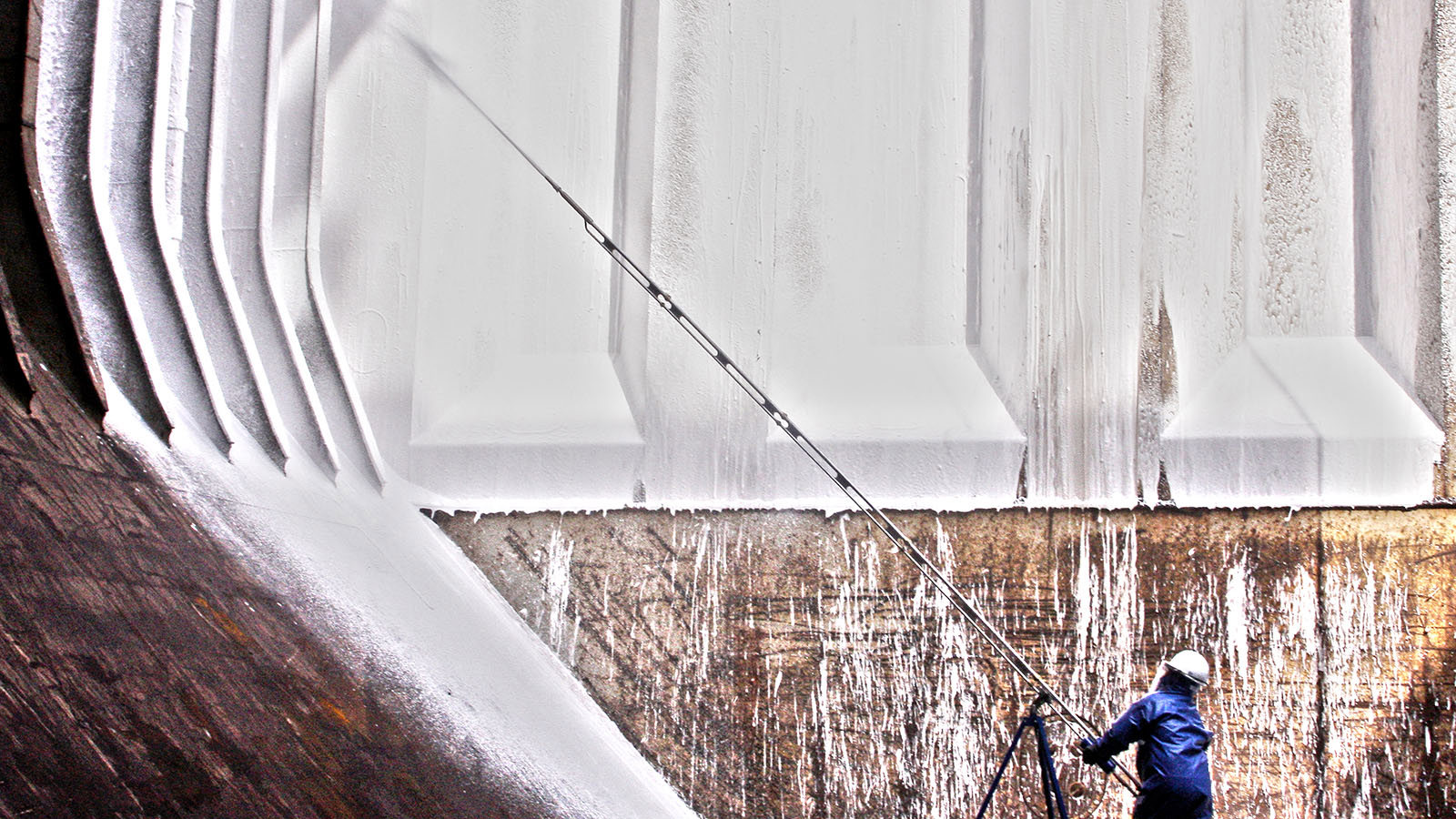Proper cargo hold cleaning procedures mean good risk management

Wilhelmsen insights
|
Jan Fredrik Bjorge, Technical Sales Manager Cargo Hold Cleaning and Tank Cleaning

The design of modern dry bulk carriers is centred around their holds and has evolved to be as efficient as possible in terms of volume of cargo carried. Whether this is coal, grain, iron ore or other bulks, the need is for fast and efficient loading, safe shipping and speedy unloading.
But what happens when the voyage is completed and the cargo holds are empty? What comes next is a crucial process that can make the difference between securing the ship’s next employment and losing a valuable charter by failing to meet regulatory requirements.
Good cargo hold cleaning is vital for dry cargo shipowners and operators. It’s a process that can directly affect the bottom line and which relies on the crew having the right tools to do their job safely and efficiently.
Bigger fleets, tougher markets
Torvald Klaveness is among the world’s leading shipowners and operators. The Oslo-headquartered company controls 130 vessels carrying some 60 million tonnes per annum of iron ore, coal, grain and bauxite on its own and chartered-in tonnage in the Baumarine and Bulkhandling pools.
Senior Operations Manager at AS Klaveness Chartering, Dagfinn Asmyhr, is a member of the team responsible for keeping this huge fleet running to schedule and in first class condition. That includes making sure the cargo holds are properly cleaned after each discharge and prepared to take the next load.
Asmyhr notes a change in practice between the booming charter markets pre-2008 and the new realities of today’s lower earning, but equally high pressure trades. Where once a discharge terminal would have ‘all but licked the holds clean’ of residual cargo, today’s lower commodity values mean they are likely to leave as much as a few hundred tonnes behind for the sake of fast vessel turnaround.
“Unloading speeds at some new terminals are such that the vessel can be handed very quickly. These ports don’t want a queue of vessels at anchor, they want them in and out as fast as possible,” he explains.
And despite the volatile markets that owners are exposed to, the overall volume of cargo carried is increasing, with more and more major bulks on the water, including new volumes of coal exports from the US that have only emerged in earnest the last few years.
“There is much more coal and iron ore being carried these days and the main importing centres of India and China are consuming so much of this cargo that some terminals will not always bother to take it all from the holds,” he adds.
Removing the residue
In extreme cases, this situation requires arguing on behalf of the owner that the vessel is not fully discharged, even though the charterers or cargo receivers want to shift the vessel from berth to commence discharging the next one. In most cases it simply means having to organise the removal and disposal of the residual material.
Often the material is caked against the side shell frames or lodged in bulkheads. Only when this process is completed can the seafarers turn their attention to cleaning the holds.
Asmyhr notes a further impact of the financial crisis on the process of keeping his ships running smoothly. Because so many newbuilding contracts were sold on by owners or repossessed by their lenders, new tonnage entering the market is often owned by financial institutions.
“Many of the owners of newbuildings now are banks who have completed the ships after owners pulled out. One might expect that a brand new ship would be fully supplied with all the necessary equipment onboard that the crew would need, but often the opposite is the case,” he says.
These owners will have met the statutory baselines needed to sail under flag and class rules but may have stopped short of fitting non-mandatory equipment. When a new ship joins the Klaveness pool, the first action is to bring the ship’s onboard inventory up to internal standards. When an older ship joins, the missing cleaning equipment will be supplied at the next convenient port.
Once the required standards have been met and the ship joins the pool it will begin trading world-wide and the challenge of keeping its holds up to scratch begins.
An enormous challenge
Probably the biggest single issue facing the crew is the size of the spaces that must be cleared of residual cargo and then cleaned to charterer requirements.
For a typical post-Panamax bulk carrier in the Baumarine pool, which could carry alternate cargoes of coal and grain, the holds can easily be 22m from the tank top [floor] to the hatch covers, as much as 38m wide and 26m long. That makes one hold equivalent to 16-17,000 cubic metres and there can be seven similar spaces to clean.
In ideal conditions, the crew may be able to start cleaning the holds while discharging is still taking place and they could have as many as three or four holds clean by the time discharging is finished, but often the time available is more limited..
“How fast you have to work depends how far you have to travel until the next port,” explains Asmyhr. “If you have just discharged coal and your next cargo will be grain and you only have a couple of days to clean to a very high standard, so it’s a huge challenge.”
Working inside a massive hold while the ship is at sea might be challenge enough but the crew must clean the hold using hoses to throw chemicals up the walls of the hold and then rinse them with cold water.
Think of it as trying to clean a dinner plate from a distance of 20 metres. If the ship has been carrying consecutive coal cargoes for example, residues will have built up in layers that are very difficult to remove from such large areas.
Once cleaning of the hold is completed the crew have to sample the resulting wash water to check that it is suitable for discharge in compliance with MARPOL Annex V and national discharge regulations. In some areas, pumping out of wash water is permitted, provided the chemicals used are approved as causing no harm to the environment. In more sensitive sea areas, no discharge is allowed at all.
The right solution
Solutions for cargo hold cleaning have traditionally been sourced ad hoc from multiple suppliers, with little attention to consistency of product quality, application or documentation. The result can be that the crew struggle with a collection of products with different applications and instructions in various languages.
This is not only inefficient but in the long run can be more costly than employing a consistent and consolidated solution to supply of equipment and materials. Predictability of supply means that owners can keep vessels to the correct standards between voyages no matter where they are in the world.
The first voyage for a ship new to the Klaveness pool will often specify an initial hold cleaning to the owners’ account and the charterer may have a minimum requirement for the standard they expect. To meet these kind of demands, it makes sense to have an agreement in place with a supplier of high quality cleaning materials able to provide them on a world-wide basis.
“The Wilhelmsen Ship Service Cargo Hold Cleaning kits meet the high standards we require onboard our ships. We have had an agreement over the last 15 years to keep their kits onboard so that we can be assured that standard is reached every time.”
Dagfinn Asmyh, Senior Operations Manager, AS Klaveness Chartering
Because the Klaveness pool fleet trades globally, the company requires that cleaning kits are stored at enough locations that ships can take the supplies in enough quantity to service the pool.
Managing financial risk
Ensuring that cleaning kits and consumables are on tap wherever they are needed is a practical requirement but it is also a form of risk management. The pressure on the crew to get the holds clean is high and the result of not being able to satisfy the charterer can hit the operator where they can least afford it.
The consequences of not meeting the standard that the charterer requires can be extreme. One piece of coal left behind can get the hold failed and then you have to bring in short term labour to fix the problems. That can mean bills running into hundreds of thousands of dollars and the risk of off-hire for the ship. Having to take the ship off-hire means you could lose your next charter so the impact can be severe.
Through a policy that prioritises the importance of hold cleaning, Asmyhr says disputes with charterers are relatively rare, but the owner or operator must know the standard they are required to meet in certain locations for particular cargoes. Klaveness keeps a close eye on vessels it takes into the pool for signs of previous maintenance or excessive wear and tear.
As with any shipboard activity, education and training of the crew are vital but not without their own issues. Crews are in regular rotation and often bring very different experiences of cleaning products and procedures. Throw in a range of nationalities and languages and following even simple instructions can be a problem.
Misunderstandings could potentially lead to non-compliance or worse, harm to the crew. Wilhemsen promotes training and education, as well as a culture that encourages sharing of information to support the crew when they use cleaning equipment. The ship’s owner or the charterer may not see the pay-off on the top line but if the right procedures keep the ship moving and trading, then they will feel it on the bottom line.
“There are two places that a shipowner needs to invest; the holds and the engine. A good engine can help you to save on fuel, but the income comes from the holds,” adds Asmyhr. “If your holds are dirty and your ship is refused a charter, then you still have all the costs but no income. At that point you will understand there is no point trying to save on items which make a difference between making money and losing it”.